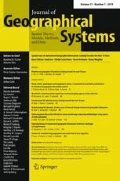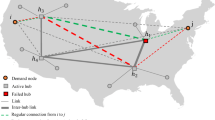Abstract
The design of survivable networks has been a significant issue in network-based infrastructure in transportation, electric power systems, and telecommunications. In telecommunications networks, hubs and backbones are the most critical assets to be protected from any network failure because many network flows use these facilities, resulting in an intensive concentration of flows at these facilities. This paper addresses a series of new hub and spoke network models as survivable network designs, which are termed p-hub protection models (PHPRO). The PHPRO aim to build networks that maximize the total potential interacting traffic over a set of origin–destination nodes based on different routing assumptions, including multiple assignments and back-up hub routes with distance restrictions. Empirical analyses are presented using telecommunication networks in the United States, and the vulnerabilities of networks based on possible disruption scenarios are examined. The results reveal that PROBA, the model with a back-up routing scheme, considerably enhances the network resilience and even the network performance, indicating that the model is a candidate for a strong survivable hub network design. An extension, PROBA-D, also shows that applying a distance restriction can be strategically used for designing back-up hub routes if a network can trade off between network performance and network cost, which results from the reduced length of back-up routings.








Similar content being viewed by others
References
Agarwal YK (1989) An algorithm for designing survivable networks. AT&T Tech J 68(3):64–76
Agrawal GP (1997) Fiber-optic communication systems, 2nd edn. Wiley-Interscience Publication, New York
AT&T (2003) The quality of Internet service: AT&T’s Global IP network performance measurements. AT&T report. http://ipnetwork.bgtmo.ip.att.net/pws/paper.pdf. Accessed 15 May 2007
Atkinson RD, Gottlieb PD (2001) The metropolitan new economy index: benchmarking economic transformation in the nation’s metropolitan area. The Progressive Policy Institute (PPI) report. http://www.neweconomyindex.org/metro/metro_3mb.pdf. Accessed 20 April 2008
Ball MO, Vakhutinsky A (2001) Fault-tolerant virtual path layout in ATM networks. INFORMS J Comput 13(1):76–94
Baybars I, Edahl RH (1988) A heuristic method for facility planning in telecommunications networks with multiple alternate routes. Nav Res Logist 35(4):503–528
Bryan D (1998) Extensions to the hub location problem: formulations and numerical examples. Geogr Anal 30(4):315–330
Campbell JF (1994) A survey of network hub location. Stud Locat Anal 6:31–49
Church RL, Scaparra MP, Middleton RS (2004) Identifying critical infrastructure: the median and covering facility interdiction problems. Ann Assoc Am Geogr 94(3):491–502
Ciabattone L, Morton A, Ramachandran G, AT&T Laboratories (2003) Standardized active measurements on a tier 1 IP backbone. IEEE Commun Mag 41(6):90–97
Clarke LW (1992) The design of survivable telecommunication networks. Dissertation, University of Pennsylvania
Colbourn CJ (1987) The combinatorics of network reliability. Oxford University Press, New York
Deeter DL, Smith AE (1998) Economic design of reliable networks. IIE Trans 30(12):1161–1174
Ghashghai E, Rardin RL (2002) Using a hybrid of exact and genetic algorithms to design survivable networks. Comput Oper Res 29(1):53–66
Gourdin E, Labbé M, Yaman H (2002) Telecommunication and location. In: Drezner Z, Hamacher HW (eds) Facility location. Springer, Berlin, pp 275–306
Gouveia L, Patrício P, de Sousa A (2008) Hop-constrained node survivable network design: an application to MPLS over WDM. Netw Spat Econ 8(1):3–21
Grötschel M, Monma CL, Stoer M (1995) Design of survivable network. In: Ball MO (ed) Handbooks in operations research and management science, vol 7. Elsevier, Amsterdam, pp 617–672
Grubesic TH, O’Kelly ME, Murray AT (2002) A geographic perspective on commercial Internet survivability. Telemat Inform 20(1):51–69
Grubesic TH, Matisziw TC, Murray AT, Snediker D (2008) Comparative approaches for assessing network vulnerability. Int Reg Sci Rev 31(1):88–112
Kim H, O’Kelly ME (2009) Reliable p-hub location problems in telecommunication networks. Geogr Anal 41(3):283–306
Klincewicz JG (1998) Hub location in backbone/tributary network design: a review. Locat Sci 6(1):307–335
Klincewicz JG (2006) Optimization issues in quality of service. In: Resende MGC, Pardalos PM (eds) Handbook of optimization in telecommunications. Springer, New York, pp 435–458
Kuby M (1987) Programming models for facility dispersion: the p-dispersion and maxisum dispersion problems. Geogr Anal 19(4):315–329
Lewis TG (2006) Critical infrastructure protection in homeland security: defending a networked nation. Wiley, New York
Liberatore F, Scaparra MP, Daskin MS (2011) Analysis of facility protection strategies against an uncertain number of attacks: the stochastic R-interdiction median problem with fortification. Comput Oper Res 38(1):357–366
Louca S, Pitsillides A, George S (1999) On network survivability algorithms based on Trellis graph transformations. In: ISCC Proceedings of the 4th IEEE Symposium on Comput Commun, pp 235–243
Maliszewski PJ, Horner MW (2010) A spatial modeling framework for siting critical supply infrastructures. Prof Geogr 62(3):426–441
Medhi D (1994) A unified approach to network survivability for teletraffic networks: models, algorithms and analysis. IEEE Trans Commun 42(2/3/4):534–548
Medhi D (1999) Network reliability and fault tolerance. In: Webster JG (ed) Wiley encyclopedia of electrical and electronics engineering. Wiley, New York, pp 213–218
Monma CL, Shallcross DF (1989) Methods for designing communications networks with certain two-connected survivability constraints. Oper Res 37(4):531–541
Murray AT, Grubesic TH (2007) Critical infrastructure: reliability and vulnerability. Springer, Berlin
Murray AT, Matisziw TC, Grubesic TH (2007) Critical network infrastructure analysis: interdiction and system flow. J Geogr Syst 9(2):103–117
Newport KT, Varshney PK (1991) Design of survivable communication networks under performance constraints. IEEE Trans Reliab 40(4):433–440
O’Kelly ME, Kim H (2007) Survivability of commercial backbones with peering: a case study of Korean networks. In: Murray AT, Grubesic TH (eds) Critical infrastructure: reliability and vulnerability. Springer, Berlin, pp 107–128
O’Kelly ME, Kim H, Kim CJ (2006) Internet reliability with realistic peering. Environ Plan B 33(3):325–343
O’Kelly ME, Bryan D (2002) Interfacility interaction in models of hubs and spoke networks. J Reg Sci 42(1):145–165
O’Kelly ME, Bryan D, Skorin-Kapov D, Skorin-Kapov J (1996) Hub network design with single and multiple allocation: a computational study. Locat Sci 4(3):125–138
Pióro M, Medhi D (2004) Routing, flow, and capacity design in communication and computer networks. Morgan Kaufmann Publishers, San Francisco
Pirkul H, Narasimhan S (1994) Primary and secondary route selection in backbone data communication networks. ORSA J Comput 6(1):50–60
Quest (2005) Quest IP network statistics. http://stat.qwest.net. Accessed 1 June 2006
Skorin-Kapov D, Skorin-Kapov J, Boljunčić V (2006) Location problems in telecommunications. In: Resende MGC, Pardalos PM (eds) Handbook of optimization in telecommunications. Springer, New York, pp 517–544
Soni S, Gupta R, Pirkul H (1999) Survivable network design: the state of the art. Inform Syst Front 1(3):303–315
Stavroulakis P (2003) Reliability, survivability and quality of large scale telecommunication systems. Wiley, New York
Torrieri D (1992) Algorithms for finding an optimal set of short disjoint paths in a telecommunication network. IEEE Trans Commun 40(11):1698–1702
Walkowiak KM (2004) A branch and bound algorithm for primary routes assignment in survivable connection oriented networks. Comput Optim Appl 27(2):149–171
Wheeler D, O’Kelly ME (1999) Network topology and city accessibility of the commercial Internet. Prof Geogr 51(3):327–339
Wu T (1992) Fiber network service survivability. Artech House, Norwood
Xin Y, Rouskas GN (2004) A study of path protection in large-scale optical networks. Photonic Netw Commun 7(3):267–278
Zeng B, An Y, Zhang Y, Kim H (2010) A reliable hub-spoke model in transportation systems. In: Proceedings of the 4th international symposium on transportation network reliability, Minneapolis, Minnesota, USA, 22–23 Jul 2010
Zook MA (2000) Internet metrics: using hosts and domain counts to map the Internet globally. Telecommun Policy 24(6/7):613–620
Author information
Authors and Affiliations
Corresponding author
Rights and permissions
About this article
Cite this article
Kim, H. P-hub protection models for survivable hub network design. J Geogr Syst 14, 437–461 (2012). https://doi.org/10.1007/s10109-011-0157-5
Received:
Accepted:
Published:
Issue Date:
DOI: https://doi.org/10.1007/s10109-011-0157-5




